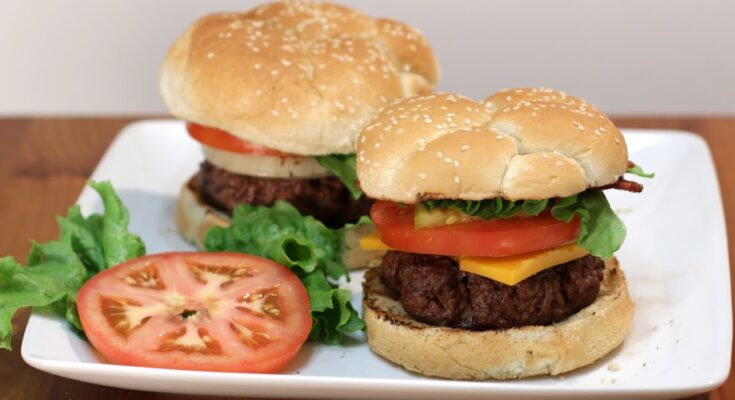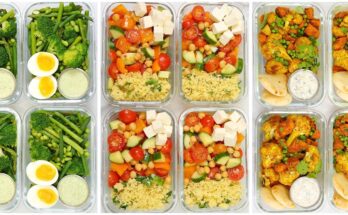Burger Recipe: What makes a burger truly great? It’s all about balance: the savory patty, the pillowy bun, the crunch of fresh toppings, and the tangy zip of condiments. While fast food burgers may be convenient, a homemade burger offers unbeatable flavor, freshness, and customization.
With a little effort and attention to detail, you’ll master the art of burger-making and impress anyone lucky enough to try your creation.
Gathering Your Ingredients
The key to a memorable burger lies in the ingredients. Start with the essentials:
- Ground beef: Look for a mix with 80% lean meat and 20% fat for a juicy patty.
- Buns: Brioche or sesame seed buns work wonderfully.
- Cheese: Classic cheddar, American, or experiment with blue cheese or Swiss.
- Toppings: Lettuce, tomato, onion, and pickles.
- Condiments: Ketchup, mustard, mayo, or aioli.
For variety, consider add-ons like avocado slices, jalapeños, caramelized onions, or fried eggs. Always opt for fresh, high-quality ingredients—they’ll make all the difference.
Choosing the Right Ground Meat
The meat is the star of the show, so choose wisely. For a classic burger:
- Beef: An 80/20 ratio strikes the perfect balance between juiciness and flavor.
- Alternatives: Try ground chicken or turkey for a leaner option, or experiment with plant-based alternatives like Beyond Meat or black bean patties.
To enhance the flavor, season the meat with salt, pepper, garlic powder, or a dash of Worcestershire sauce.
Crafting the Perfect Burger Patty
Here’s how to form the ideal patty:
- Mix with care: Combine the meat and seasonings gently to avoid compacting the mixture.
- Shape evenly: Divide the meat into equal portions and roll each into a ball, then flatten slightly to form patties about ¾ inch thick.
- Create an indent: Press your thumb into the center of each patty to prevent puffing during cooking.
Avoid overworking the meat—it can make the patties tough and dense.
Preparing the Perfect Bun
The bun holds everything together and deserves special attention. Consider these tips:
- Selection: Brioche buns add a hint of sweetness, while pretzel buns provide a chewy texture. For health-conscious eaters, whole-grain or gluten-free buns are excellent choices.
- Toasting: Lightly toast your buns in a pan with butter or on the grill to enhance their flavor and prevent sogginess.
A perfectly toasted bun adds structure and warmth, completing your burger experience.
Cooking Techniques for Burgers
The cooking method you choose will influence the final flavor and texture:
- Pan-frying: Heat a skillet over medium-high heat, add a bit of oil, and cook each side for about 3-4 minutes for medium doneness.
- Grilling: Preheat your grill and cook the patties for 3-5 minutes per side, depending on thickness and desired doneness.
- Baking or air frying: A great alternative for a healthier approach. Bake at 375°F for 15-20 minutes, flipping halfway.
Whichever method you choose, let the patties rest for a few minutes before assembling your burger to lock in the juices.
Adding Cheese to Your Burger
Cheese is the crown jewel of any burger. Here’s how to get it just right:
- Select your cheese: While cheddar and American cheese are classics, don’t shy away from experimenting. Swiss, pepper jack, Gouda, or even blue cheese can elevate your burger.
- Melt it properly: Place the cheese on the patty about a minute before it’s done cooking. Cover the pan or grill to trap the heat and melt the cheese evenly.
- Layer with care: If you’re using multiple types of cheese, stack them wisely for a balanced flavor.
A perfectly melted slice of cheese can transform your burger into a mouthwatering masterpiece.
Building Your Burger – Layering Like a Pro
How you stack your ingredients impacts not just the flavor but also the structural integrity of your burger. Here’s the ideal order:
- Base layer: Spread a light coat of mayo or your preferred condiment on the bottom bun.
- Lettuce: Place a crisp lettuce leaf to prevent the patty juices from soaking the bun.
- Patty: Add your cooked patty with melted cheese.
- Toppings: Layer sliced tomato, onion, and pickles.
- Condiments: Add ketchup, mustard, or any specialty sauces on top.
Finally, crown it with the toasted top bun. This method ensures every bite is flavorful and keeps the burger intact as you eat.
Side Dishes That Complement Your Burger
A great burger deserves equally delicious sides. Consider these classics and alternatives:
- Fries: Whether traditional, sweet potato, or seasoned wedges, fries are a timeless choice.
- Onion Rings: Crunchy and golden, they add a satisfying contrast.
- Healthier options: Opt for side salads, roasted vegetables, or air-fried zucchini for a guilt-free meal.
Pair your burger with a refreshing drink like lemonade, iced tea, or even a craft beer for the ultimate feast.
Tips for Customizing Your Burger
One of the joys of making burgers at home is the freedom to get creative. Here are some ideas:
- Adjust spice levels: Add jalapeños, hot sauce, or chipotle mayo for a spicy kick.
- Unique toppings: Experiment with pineapple, guacamole, or crispy bacon.
- Vegetarian options: Swap the meat patty for a black bean burger, lentil patty, or portobello mushroom cap.
Customization ensures your burger is tailored to your taste, making every bite a personal delight.
Common Mistakes to Avoid
Even experienced cooks can stumble. Here are pitfalls to steer clear of:
- Overcooking the patties: Keep an eye on cooking times to avoid dry burgers.
- Skipping bun prep: A cold, un-toasted bun can ruin the texture.
- Overloading toppings: While tempting, too many toppings can overpower the patty and make your burger messy.
Avoiding these mistakes will ensure your burger is as tasty as it looks.
Storing and Reheating Leftovers
Leftovers? No problem. Follow these tips to enjoy your burger again:
- Storage: Wrap the burger in foil or store the components separately in airtight containers. Refrigerate within 2 hours of cooking.
- Reheating: Warm the patty on low heat in a skillet or microwave. Toast the bun separately to restore its texture.
- Repurposing: Use leftover patties in wraps, salads, or breakfast sandwiches for a creative twist.
With proper care, your burger can taste almost as good as it did fresh off the grill.
Serving Suggestions and Presentation Tips
Make your burger look as good as it tastes. Here’s how:
- Plating: Serve on a wooden board or stylish plate for a rustic vibe.
- Garnishes: Add a side of fresh herbs, a pickle spear, or a small salad for extra flair.
- Hosting tip: Set up a burger bar with various toppings and sauces for guests to customize their burgers.
Presentation enhances the dining experience and makes your homemade burger feel extra special.
FAQs about Burger Recipe
What is the best meat to use for a burger?
For the juiciest burgers, use ground beef with a high fat content, ideally around 20% fat. Ground chuck is a popular choice because it has a good balance of fat and flavor, making it perfect for grilling.
How do you make sure burgers are cooked properly?
To ensure your burgers are cooked safely and to your liking, use a meat thermometer. The USDA recommends cooking ground beef to an internal temperature of 160°F (71°C) to ensure all bacteria are killed. If you prefer your burger less well-done, keep an eye on the temperature and remove from heat once it reaches your desired doneness.
Should I season my burger meat?
Yes, seasoning the meat before forming your patties can greatly enhance the flavor. Simple salt and pepper work well, but you can also experiment with garlic powder, onion powder, or any other spices that suit your taste.
What are some creative toppings for burgers?
Beyond the classic lettuce, tomato, and onion, consider adding avocado slices, caramelized onions, sautéed mushrooms, a fried egg, or even coleslaw. Cheese options can vary from the traditional American or cheddar to more unique choices like blue cheese or goat cheese.
How do I prevent my burgers from puffing up in the center while cooking?
A common trick is to press a small dimple into the center of your burger patties with your thumb before cooking. This helps the patties to cook evenly and stay flat rather than puffing up in the middle.
Can burgers be made healthier?
Absolutely! For a healthier burger, opt for lean ground beef, turkey, or even a vegetarian patty. Use whole grain buns, add plenty of fresh vegetables as toppings, and consider lower-fat cheese options or a yogurt-based sauce.
What’s the key to a juicy burger?
Avoid overworking the meat when forming patties and don’t press down on the burgers while they cook, as this squeezes out the juices. Keeping the patties at an even thickness and using a pre-heated cooking surface can also help retain juiciness.
Conclusion
Making a burger at home is more than just cooking—it’s an art that brings together flavor, texture, and creativity. With this step-by-step guide, you’re ready to craft a burger that satisfies your cravings and impresses anyone who takes a bite. So, fire up the grill or heat that skillet—it’s time to create your burger masterpiece!



